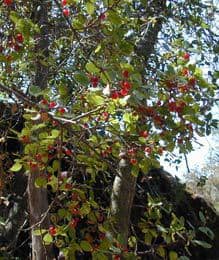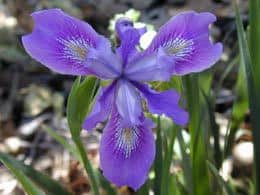Shady Native Color – Ribes aureum, Rhamnus ilicifolia, Iris douglasiana, Heuchera sp.
Shady Native Color

At Tree of Life we want to help brighten up those shady areas of your home garden or landscape. Why not plant some beautiful native plants? Plant these shrubs and perennials and sit back to see songbirds, hummingbirds, and butterflies enjoy them! Read more about our featured plants this month: Golden currant (Ribes aureum) and Redberry (Rhamnus ilicifolia) available in five gallon container sizes, and, Pacific Coast Iris (Iris douglasiana) and Coral Bells (Heuchera sp.), currently available in one gallon size.
 Looking to fill in some space in shady sections of your landscape? Provide valuable habitat and beautiful berries for songbirds by planting
Looking to fill in some space in shady sections of your landscape? Provide valuable habitat and beautiful berries for songbirds by planting ![]() Ribes aureum or Rhamnus ilicifolia. Available now, we have beautiful five-gallon Ribes aureum. These plants grow four to six feet high and are characterized by their bright green leaves and arching branches. They have numerous small yellow flowers, (pictured) which fade to orange and are followed by a light orange berry. This landscape-friendly, delicate-looking native would be nice treat for native pollinators in place of Escallonia or Abelia. The berries are the birds’ favorite.
Ribes aureum or Rhamnus ilicifolia. Available now, we have beautiful five-gallon Ribes aureum. These plants grow four to six feet high and are characterized by their bright green leaves and arching branches. They have numerous small yellow flowers, (pictured) which fade to orange and are followed by a light orange berry. This landscape-friendly, delicate-looking native would be nice treat for native pollinators in place of Escallonia or Abelia. The berries are the birds’ favorite.
 Also extremely desirable for providing precious habitat, we have beautiful 5-gallon Rhamnus ilicifolia available now. Ideal for restoration projects and useful for native plant gardens, this plant has shiny dark green leaves and provides beautiful bright red berries (pictured). Growing five to seven feet tall, it would work well as an informal hedge or screen.
Also extremely desirable for providing precious habitat, we have beautiful 5-gallon Rhamnus ilicifolia available now. Ideal for restoration projects and useful for native plant gardens, this plant has shiny dark green leaves and provides beautiful bright red berries (pictured). Growing five to seven feet tall, it would work well as an informal hedge or screen.
Please call the sales office with inquiries.
Bursts of Color!
Looking for some low growing color this spring in shady areas? Consider planting Douglas Iris and Heuchera maxima or Heuchera hybrids. These shade-loving native plants are the perfect solution for brightening up shady areas you may have under an oak, along the eaves of your house, or in containers on a patio. They are excellent planted in mass, (pictured), and will tolerate light irrigation.

![]() Iris douglasiana and Pacific Coast Hybrid Iris are evergreen clumping perennials with linear leaves and three-inch flowers ranging from white and pale lavender to deep purple. They actually remind some people of orchids, as the colorings and forms are so unique! The hybrids provide a wide array of flower form and color including golds, yellows, bicolors, whites, and occasional reds. Iris bloom profusely in the spring and are excellent when planted with Coral Bells (Heuchera sp.).
Iris douglasiana and Pacific Coast Hybrid Iris are evergreen clumping perennials with linear leaves and three-inch flowers ranging from white and pale lavender to deep purple. They actually remind some people of orchids, as the colorings and forms are so unique! The hybrids provide a wide array of flower form and color including golds, yellows, bicolors, whites, and occasional reds. Iris bloom profusely in the spring and are excellent when planted with Coral Bells (Heuchera sp.).
Coral Bells, ![]() Heuchera hybrids and Giant Alum Root
Heuchera hybrids and Giant Alum Root ![]() Heuchera maxima, offer profuse flowers in the spring. Heuchera are compact rosette-forming perennials with pretty rounded leaves and delicate flowers atop slender stems rising 1-3 feet above the foliage.
Heuchera maxima, offer profuse flowers in the spring. Heuchera are compact rosette-forming perennials with pretty rounded leaves and delicate flowers atop slender stems rising 1-3 feet above the foliage.
 Flower colors in Heuchera hybrids are more intense, while the paler Heuchera maxima has the tallest flower stalks and largest leaves. Both types range from white to pink, and some hybrids are even red. These attractive groundcovers bloom from early spring into summer. The ‘Canyon’ series of small-leaved Heuchera hybrids make a delightful addition to shady areas, and exhibit the full color range of the genus. (Hybrid names: Heuchera ‘Bella Blanca’, ‘Canyon Duet’, ‘Canyon Pink’, ‘Canyon Chimes’ and more!)
Flower colors in Heuchera hybrids are more intense, while the paler Heuchera maxima has the tallest flower stalks and largest leaves. Both types range from white to pink, and some hybrids are even red. These attractive groundcovers bloom from early spring into summer. The ‘Canyon’ series of small-leaved Heuchera hybrids make a delightful addition to shady areas, and exhibit the full color range of the genus. (Hybrid names: Heuchera ‘Bella Blanca’, ‘Canyon Duet’, ‘Canyon Pink’, ‘Canyon Chimes’ and more!)
Both Heuchera and Iris share similar horticultural requirements. Their flowers and contrasting foliage compliment each other well. These plants attract hummingbirds and other pollinators with their showy flowers. With them, you not only gain spring color in challenging shady sites, but also a few welcome spring visitors!
If you would like to learn about even more native choices for those tricky shady spots, please see our ![]() Dry Shade Sage Advice. For more songbird attracting, berry producing favorites, please see our
Dry Shade Sage Advice. For more songbird attracting, berry producing favorites, please see our ![]() Natives for Songbirds. We hope that you enjoy this spring season, with its (brief) light showers and, of course… we hope you have had a chance to get out and see some beautiful blooming California native plants!
Natives for Songbirds. We hope that you enjoy this spring season, with its (brief) light showers and, of course… we hope you have had a chance to get out and see some beautiful blooming California native plants!
Happy planting!